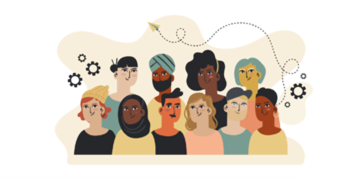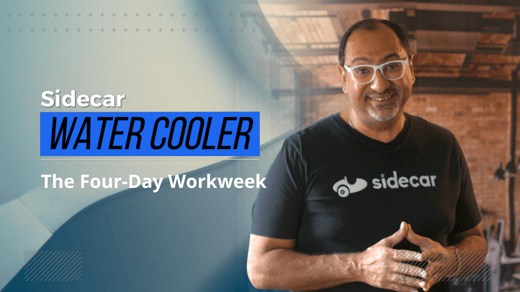Workplace culture (also commonly referred to as organizational culture) is a blanket term for the accepted practices, morals, values and processes that guide how people interact at work. The predominant style of workplace culture can shift dramatically, especially in times of extreme change or upheaval. One good example is during World War II when women entered the workforce, but the most recent one is the Covid-19 pandemic. With deep and ongoing discussions that start with remote, hybrid and in-person work, associations are challenged in 2023 to examine their workplace culture and adapt.
Here’s what that means for you.
What’s included in workplace culture
It’s clear that the culture of work has changed, and in the same breath so has how we actually define workplace culture. In the stereotypical office of the 1950s, smoking was permitted and cocktails at lunch were common. This was accepted practice and part of the culture — business was conducted during alcohol-fueled lunches (and naps may have been part of the afternoon schedule).
These days, business looks very different, and most organizations focus on four factors.
1. Place
The global pandemic changed where we do business. Many offices shut down completely and never reopened a physical space, while others have mandated an in-person return at the risk of unemployment. Still, others are struggling to navigate the hybrid space between fully remote and completely in-person.
And the decision is complicated. Many employees found a better balance when they worked solely at home, while others couldn’t wait to get away and back to work where it was easier to focus.
While some businesses center in-person interactions as a cornerstone of their culture, there is a definite disconnect between the culture employees want (remote or hybrid options) and the emphasis on full-time, in-person work. Of the 10,000 people surveyed by The Future Forum, 44% of executives preferred in-person work, citing an energized and more connected feeling, but only 17% of employees agreed. Some employees believe some of this push for full-time work at the office is more about supervision and old-school ways of thinking, but executives insist it’s more about collaboration and teamwork.
If your organization is trying to figure out which is best, a 2022 study by Owl Labs found that remote and hybrid employees were 22% happier than fully onsite workers. And another survey of 1,000 workers conducted by Ergotron found that 56% of respondents felt their mental health was stronger in a hybrid environment.
Either way, in the great workplace culture shift of 2023, it’s clear the conversation has to start with where work gets done.
2. Process
Once an organization decides where work gets done, how it gets done — the workflow or process — is next. With technology continuing to innovate and new generative AI tools taking all aspects of work by storm, systems are changing dramatically to support an elevated workplace culture.
Read more: Place, Process, DEI and Wellness: Workplace Culture in 2023No matter where people are working, it's critical to understand the work that needs to get done and what it requires. This is not a one-size-fits-all approach; rather, each business must decide what process produces optimal results (regardless of the way things have been done in the past).
Associations in particular have unique needs and priorities — they often serve a specific population with a laser-focused mission. It’s important to have processes in place that serve as a roadmap to that destination.
3. DEI
Diversity, Equity and Inclusion (DEI) are critical aspects of workplace culture. Making DEI a part of your association asks:
- Do employees feel valued?
- Do employees feel they have an equal voice?
- Are employees comfortable giving feedback?
- Are employees welcomed at all levels of leadership?
- Is compensation for all employees fair?
- Do employees feel like they can bring their authentic self to work?
- Are employees comfortable bringing their concerns about harassment or discrimination to HR?
- Are appropriate accommodations in place for everyone who needs them?
- Is there a system in place for handling conflict between employees, employees and managers, and employees and the public?

Intro to DEI for your Association
What is DEI? Diversity, Equity and Inclusion (DEI) is vital to creating and maintaining a successful organization, one that is founded and rooted on the principles that all people within your association can thrive.
It goes deeper than simply looking for diversity of race. A workplace with a culture of diversity, equity, and inclusion also includes diverse:
- Gender
- Religion
- Sexual orientation
- Socioeconomic status
- Ethnicity
- Language
- Ability
- Age
- Political and religious perspective
Diversity pays off. The most diverse workplaces experience 2.5 times the cash flow of monocultures and are able to capture 70% of new markets.
But while most companies understand that a diverse and inclusive workplace culture is better for the bottom line, movement is slow. In 2022, just six CEOs of Fortune 500 companies were Black, and 46% of employees said that discrimination remained an issue.
It’s a cultural shift in 2023 that can’t wait any longer.
4. Wellness
Gone are the days of wellness as an individual responsibility, especially for the 34% of workers who spend 40 hours or more at work. While not every association is able to offer a Google-like suite of wellness benefits, a culture that supports employee wellness can be as simple as adding flexible hours for parents or paid time off for mental wellness and physical therapy.
Another critical aspect is recognizing that wellness is worth paying for. In addition to providing a comprehensive array of benefits as part of a workplace that values wellness, some companies are recognizing that financial incentives for taking advantage of them are important, too.
10 steps to change workplace culture in 2023
In a Deloitte 2023 Global Human Capital Trends survey, 87% of organizational leaders believed that workplace culture is very important.
The bad news? Of those leaders who wanted to focus more on changing the place and process of work, only 24% felt prepared to make changes.
It can be a long road, but there are 10 steps to get your business started on the path.
- Decide on a vision: What is the ideal workplace culture?
- Create a working group: Include people at all levels of the company.
- Identify the current culture: Start where you are.
- Identify what needs change: Solicit input from the entire company.
- Set a deadline and a budget: Change costs money, and it takes time. Commit both to this effort.
- Utilize the proper tools: Technology can help change workplace culture. If your team moves fully remote, what tools will you need to make sure everyone stays connected?
- Be the change: Leaders need to model the change they want.
- Move thoughtfully: Implement big changes in small steps.
- Evaluate: What’s working, and what needs more time?
- Celebrate: Recognize successes.
Workplace culture — designing the future
The relationship between employees and their work has changed, and it’s up to the workplace to learn, grow, and adapt. As we emerge more fully from the pandemic, the time for making substantive improvements to workplace culture is now.

February 7, 2023

